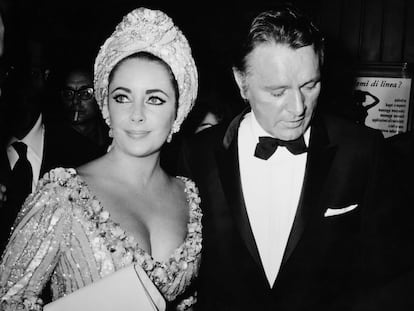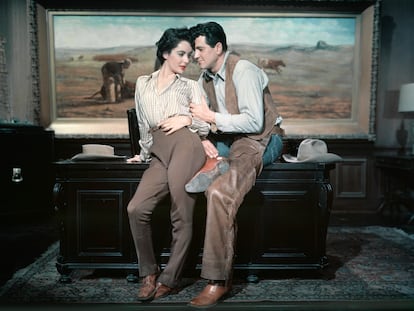Richard Burton, the temperamental Welshman who never got used to being a superstar’s spouse
Forty years ago, the world bid adieu to one of Hollywood’s great performers who was, at the same time, an ambivalent man who wanted to be an actor, but wound up becoming the most scrutinized star of his time

One summer night, when the singer Eddie Fisher found out that Elizabeth Taylor had just returned to Hollywood after finishing up the colossal shooting of her film Cleopatra (1963) in Italy, he rushed to the nearest telephone to welcome his spouse home. But the person who picked up on the other end wasn’t her — instead, a masculine voice answered the call. Fisher recognized it instantly: it was that of Richard Burton, who was born in Pontrhydyfen, Wales in 1925 and would die in Switzerland on a day like today in 1984, some 40 years ago. Burton had been Taylor’s co-star and Fisher had met him in person on a recent trip to Rome. What the singer couldn’t understand was what the actor was doing in the home he shared with Taylor, but Burton didn’t leave much room for doubt when posed the question: “What do you think I’m doing? I’m fucking your wife.”
Rumors of the romance that Burton so coolly confirmed had inspired an avalanche of tabloid magazine covers since the very beginning of the Cleopatra shoot. But who listened to such accounts when they were with a star of Taylor’s magnitude? She had been the media’s favorite prey since childhood and just a few months ago, had stood squarely in the spotlight thanks to a scandal that had raised eyebrows even in Hollywood: Taylor and Fisher had started their romance just six months after the airplane accident that had taken the life of her husband Mike Todd. It’s worth noting that Fisher was not just Todd’s best friend, but also the husband of Debbie Reynolds, Taylor’s supposed pal.

The weight of Taylor and Burton’s guilt seemed, for a moment, to halt their love story, but the couple quickly made the decision to carry on, against the odds and everyone else’s wishes, turning a blind eye to popular disapproval — including the Vatican’s direct condemnation — which only wound up lending a romantic aura to the couple that would render Taylor the most famous person on the planet, reconfiguring the very notion of popularity. Burton would later say that he hadn’t understood what fame really was until the first day he walked down the street with Taylor. Coming from one of the world’s best-known actors, who already had two Oscar nominations under his belt, that is quite the statement.
Burton had been born 37 years before in a small town in southern Wales. It was an unforgiving atmosphere for a little boy whose mother was dead and whose father was largely absent and whose disappearances into the thick of local pubs for days, if not weeks, were part of the family’s reality. The young Burton’s loneliness would end up forging a rough and tough young man who didn’t seem to be afraid of anything. His first night in London coincided with one of the regular Luftwaffe bombings of the city that had been taking place since the start of the war. Rather from running to shelter when he heard the sirens, Burton decided to ascend to the roof of his building so as not to miss the show.
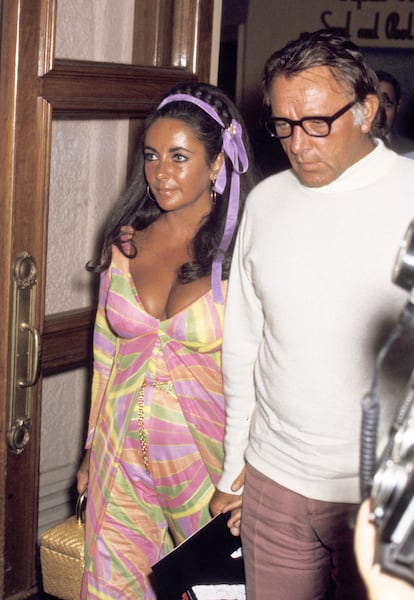
He had arrived in the city that day because he had decided to audition for a play. At the time, Burton was 15 years old and his life seemed limited to rugby, tobacco and alcohol. But the first time he set foot on a stage, he felt a magnetic force that seemed to make sense of it all. “He was already a star without knowing it,” one of his first paramours, actress Claire Bloom, would later recall. A brilliant student, he didn’t finish his studies at Oxford thanks to a sharp rise as a prodigious performer, who was recognized as an equal by John Gielgud and Laurence Olivier, two actors qualified as national treasures, after they saw him do Shakespeare. Producer Alexander Korda saw that in Burton, he had a gold mine on his hands, and didn’t hesitate to offer him a Hollywood contract.
And yet, Burton never seemed fully comfortable no matter where he went. Money came in spurts, the aura of respect that enveloped him led to Oscar nominations starting with his first film, My Cousin Rachel (1953). But the actor understood that Hollywood could never offer roles of his stature and didn’t hesitate to take arms against the studio machinery that he ultimately despised. His fight that broke out against Fox’s army of lawyers upon Burton breaking his million-dollar contact with the studio to return to London to play Hamlet for $57 a week would become the stuff of legend. It was at the victory party after this scuffle that Burton saw Elizabeth Taylor for the first time. He was dazzled by those violet-colored eyes. His attention, however, moved to another part of her body when they were reunited for the shooting of Cleopatra, or so it would seem, given that upon seeing her, Burton coined the nickname “Miss Tits”. Taylor loved it. A few days later, when he came drunk to a party the actress was hosting in her luxurious villa in Appia Antica, shouting, “Elizabeth, come here and stick your tongue in my mouth!”, she complied, in front of all her guests.
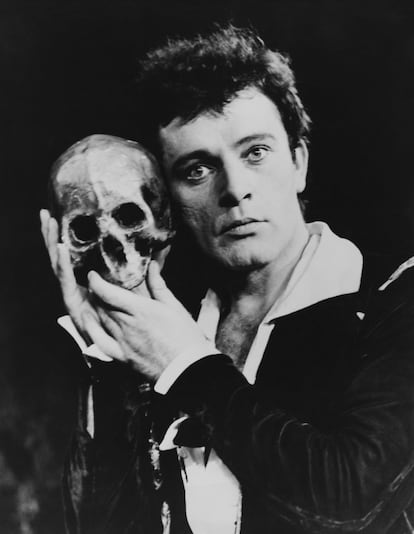
Their explosive reunion seemed to portend everything would follow, a legendary decade lived under a continuous media spotlight that rendered them the quintessence of 1960s glamour, immersed in a high-profile circus of dimensions previously unseen, harassed by dozens of photographers who were easily confused with the thousands of fans that followed them everywhere, causing chaos on red carpets and in hotels and airports. Taylor, who had been subject to such treatment since childhood, kept a smile on her face. But Burton did not share her ability to maintain one’s composure, and accounts of his scuffles and fisticuffs became commonplace.
“They were gods,” said actor Michael York after playing alongside the couple in The Taming of the Shrew (1967), whose shooting gave him ample time to gawk at their dressing rooms, which they had converted into luxury suites featuring silk, tapestries and works of art. Private airplanes and yachts, mansions in every corner of the world, parties with the Rothschilds, the Prince and Princess of Monaco and the Duke and Duchess of Windsor — they even traveled with a small army tasked with guarding Taylor’s jewels. One of these would famously be gifted to her by Burton after he placed a million-dollar bid via telephone in an English pub, beating out Aristotle Onassis in its auction. Their turns on the silver screen confirmed their dazzling brilliance: projects with Huston, Minnelli and Losey, Oscar wins and nominations, and what came to be quite possibly Burton’s most memorable performance in Becket (1964).
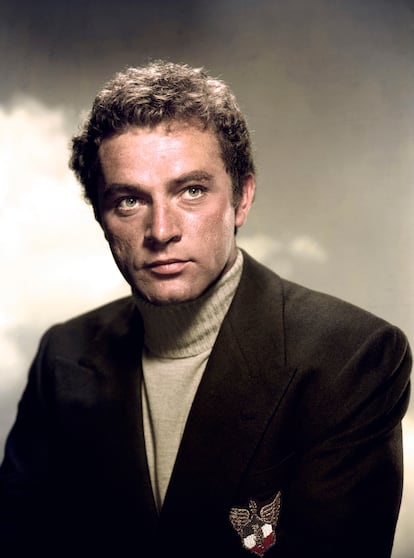
The couple never hid their passion, nor the ups and downs that characterized their day-to-day existence. Theirs was the pairing of a small-town boy and a lifelong star, the luxury boutiques she favored in Paris and New York making for stark contrast with the fish and chips and pubs in which Burton loved to get lost whenever possible. Their dealings were fueled by an omnipresent supply of alcohol. When Burton was asked if anyone had ever been able to outdrink him, he boasted that he’d never met a man capable of the feat — he was always gender-specific, because he knew that Taylor was an unbeatable opponent. So explosive was their love that it became rife with insults, fights and even blows (some Taylor biographers like J. Randy Tarraborelli claim that Burton struck her; the actor’s heirs categorically deny the claim) that were not relegated to their private life, given that their spats would often take place at parties, restaurants, sets and television studios.
As actors ever-conscious of their legendary status, they never doubted to bring all this material to the screen. Their love story would be reflected in the dozen films they made together — “We’re going to wind up like Laurel and Hardy,” Burton liked to joke — the beginning of their decline visible in Who’s Afraid of Virginia Woolf? (1966), an adaptation of an unsettling stage production that follows a couple’s destruction and which few failed to view as autobiographic. But with the arrival of the ‘70s, the end of their loop of toxic extremes seemed to be in sight. In 1969, Burton confessed to his diary, “I’ve always been a drinker, but during these last months Elizabeth and I seem to be on the brink of killing ourselves.” From then on, his pages began to take on somber tones, until being abruptly interrupted by the day in 1972 when the phone call came that announced the death of Burton’s brother Ifor, who had been paralyzed for years after breaking his neck during one of the siblings’ drunken benders.
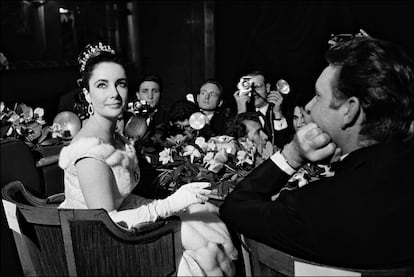
Assaulted by his depression, one night Burton sat down in front of the television to watch an interview he’d filmed a few days back. He found himself unable to recognize the clumsy, swollen, prematurely aged man before him. It was then that he decided to take the first step towards sobriety. The couple’s inevitable end was captured in what would be their last project together, a film that was actually two, Divorce His, Divorce Hers (1973), in which they portrayed the story of a divorce with unusual rawness from two points of view. Their director, Waris Hussein, remembered how Burton started the filming sober, with a bottle of water in hand. But the day that Elizabeth showed up on set, the Perrier was replaced by vodka. Their rudderless boat had definitively sank and their separation was announced later that summer.
A reconciliation, even another wedding, followed, but Burton’s return from the Botswana ceremony infected with malaria proved to be an ominous sign. A few months later, they would split for good. “We wound up tearing each other apart,” he wrote in the final pages of his diary.
By the time Burton embarked on the filming of The Klansman in 1974, his appearances had begun to form part of a spectacle of personal degradation that was on display for all to see. Sharing the limelight with one of Hollywood’s most hardened drunks, Lee Marvin, also proved to be a bad idea. The most complicated scene in the film was Burton’s death at the hands of the Ku Klux Klan. Upon its conclusion, director Terence Young delivered his congratulations to the makeup team for the realism they’d achieved in transforming Burton into a corpse. They hadn’t had to do much, they confessed — the actor’s real-life appearance had done most of the work for them. At the end of the filming, Burton was rushed to the hospital, where doctors gave him no more than three months to live. Once again, he defied expectations, managing to pull through. But he was never the same man. He lived under the constant supervision of doctors and nurses, falling asleep at every script reading, cynically signing onto a parade of films and made-for-TV movies that ultimately had only his name to offer audiences. For Burton, they were only a means to financing an endless parade of rehabs as taxing and useless to him as the inevitable relapses that followed.

The life of the actor who once had the world at his feet came to an end on August 5, 1984. Burton didn’t made it to his 60th birthday. His final film was 1984, an adaptation of George Orwell’s novel that had been shot to commemorate the arrival of its titular year. It was in keeping with the same dreary spirit that had characterized the rest of the projects that made up the final stretch of his career. His final great work had taken place long ago, in 1978. It was an action film called The Wild Geese that had given him the opportunity to reunite with two old friends, alcoholics and fighters all: Richard Harris and Roger Moore. The media traveled to South Africa to report on a shooting that, in light of the trio’s records, was expected to be apocalyptic. Journalists were surprised to find upon their arrival that there was not a trace of alcohol to be found on set. To the contrary, after each day of professional work, the three performers sat underneath a tree chatting, remembering old times and enjoying the region’s spectacular sunsets, smiling all the while. Years later, actor Ronald Fraser revealed that when he arrived on set, he was greeted by a familiar odor emanating from a nearby farm. He eventually got a hold of a few bags of freshly grown marijuana, which he generously distributed among the cast and crew. “We were all very happy those days,” he recalled.
Sign up for our weekly newsletter to get more English-language news coverage from EL PAÍS USA Edition
Tu suscripción se está usando en otro dispositivo
¿Quieres añadir otro usuario a tu suscripción?
Si continúas leyendo en este dispositivo, no se podrá leer en el otro.
FlechaTu suscripción se está usando en otro dispositivo y solo puedes acceder a EL PAÍS desde un dispositivo a la vez.
Si quieres compartir tu cuenta, cambia tu suscripción a la modalidad Premium, así podrás añadir otro usuario. Cada uno accederá con su propia cuenta de email, lo que os permitirá personalizar vuestra experiencia en EL PAÍS.
¿Tienes una suscripción de empresa? Accede aquí para contratar más cuentas.
En el caso de no saber quién está usando tu cuenta, te recomendamos cambiar tu contraseña aquí.
Si decides continuar compartiendo tu cuenta, este mensaje se mostrará en tu dispositivo y en el de la otra persona que está usando tu cuenta de forma indefinida, afectando a tu experiencia de lectura. Puedes consultar aquí los términos y condiciones de la suscripción digital.
More information
Archived In
Últimas noticias
Maude Apatow, from acting in ‘Euphoria’ to directing: ‘There are many films that you can tell weren’t written by someone young’
The life of a delivery driver in China: ‘Many people don’t know how an order can arrive at their home in just one day’
The guardians of the meteorites of the Argentine Chaco
Helen Levitt, the photographer who captured the theater of the everyday
Most viewed
- Christian Louboutin: ‘Young people don’t want to be like their parents. And if their parents wear sneakers, they’re going to look for something else’
- US sanctions against jailed cartel leader ‘El Marro’ highlight Mexico’s lack of control over its prisons
- Cartels in Mexico take a leap forward with narco-drones: ‘It is criminal groups that are leading the innovation race’
- Liset Menéndez de la Prida, neuroscientist: ‘It’s not normal to constantly seek pleasure; it’s important to be bored, to be calm’
- ‘El Limones’ and the growing union disguise of Mexican organized crime
